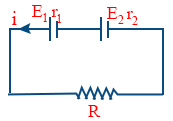Current Electricity
Cells, EMF and Internal Resisance
- A cell is device which converts chemical energy into electrical energy.
- The EMF of a cell is defined as the work done in moving unit positive charge in the whole circuit.
- The EMF of a cell is depends only on nature of electrodes and electrolyte.
- Internal resistance is the resistance offered by electrolyte between anode and cathode.
- Internal resistance depends on area and size of plates and distance between the plates. Electrolyte of temperature.
- The terminal potential difference is the work done in moving unit positive charge from anode to cathode.
- The voltage dropped across the terminals of internal resistance is called lost volt.
- Terminal potential difference V = E – ir.
- EMF developed in the cell against the emf of the cell called Back EMF.
-
\tt i = \frac{E_{1} + E_{2}}{r_{1} + r_{2} + R}
- Terminal potential difference across first cell V1 = E1 – ir1.
- Terminal potential difference across second cell V2 = E2 – ir2.
- When "n" cells of emf E and internal resistance "r" are connected in series. Then current \tt i = \frac{nE}{R+ nr}
- When out of ‘n’ cells ‘m’ cells are connected wrongly effective emf = (n – 2m) E.
- If two cells of different EMF are connected in parallel \tt E_{eq} = \frac{E_{1} r_{2} + E_{1}r_{2}}{r_{1} + r_{2}}
- Current “i” when E1, E2 connected in parallel \tt i = - \frac{E_{1}r{2} + E_{2} r_{1}}{r_{1}r_{2} + R(r_{1} + r_{2})}
- When ‘n’ cells each of emf ‘E’ and internal resistance ‘r’ are connected in parallel. Current \tt I = \frac{E}{R+ (\frac{r}{m})}
- If R << \tt \frac{r}{m} Then \tt I = \frac{mE}{r}
- If R >> \tt \frac{r}{m} Then \tt I = \frac{E}{R}
- "n" cells in series such ‘m’ cells are in parallel. Then Net resistance of circuit \tt R + \frac{nr}{m}.
- Current in the above \tt i = \frac{nmE}{mR + nr}.
View the Topic in this video From 25:39 To 43:51
View the Topic in this video From 0:44 To 35:44
Disclaimer: Compete.etutor.co may from time to time provide links to third party Internet sites under their respective fair use policy and it may from time to time provide materials from such third parties on this website. These third party sites and any third party materials are provided for viewers convenience and for non-commercial educational purpose only. Compete does not operate or control in any respect any information, products or services available on these third party sites. Compete.etutor.co makes no representations whatsoever concerning the content of these sites and the fact that compete.etutor.co has provided a link to such sites is NOT an endorsement, authorization, sponsorship, or affiliation by compete.etutor.co with respect to such sites, its services, the products displayed, its owners, or its providers.
1. Relation between ε, V and R
The voltage across R is
V = IR

